Hell on Earth
Any visitor to Cambodia should reflect on this country’s recent history. Cambodia gained independence from France in November 1953. King Sihanouk abdicated the throne two years later, placing his father in power. But Sihanouk formed a political party, the People’s Socialist Communist Party, that gained power by taking every seat in parliament in the 1955 elections. For the next 15 years, Sihanouk was at the top of Cambodia politics.
Sihanouk was suspicious of the United States and in the 1960’s turned to the North Vietnamese and the Chinese for support. Socialist economic policies alienated the right; leftists were upset over internal policies that stifled any form of dissent. Sihanouk felt most threatened by the leftist rebels and instituted repressive policies. One of the rebel groups forced to flee into the jungle for safety was the Khmer Rouge.
Cut to the mid 1970’s. Sihanouk has been deposed by General Lon Nol. U.S. and South Vietnamese forces have invaded the country in an effort to root out the communists. The U.S. institutes a secret policy of bombing communist camps, killing hundreds of thousands. Rural Cambodia falls under the control of the rebels. Pol Pot, a Paris-educated leader of the Khmer Rouge, has formed an army and on April 17, 1975, captures Phnom Penh, taking over the city and setting the clocks back to “Year Zero.” His goal is to turn Cambodia into an agrarian cooperative society under a fusion of idealistic Marxist and Maoist theories.
The reality that ensues is one of the most repressive, bloody and terrifying chapters in modern history.
Pol Pot cleared Phnom Penh of people, relocating residents to the countryside. He then instituted a program to cleanse the country of its/his enemies. The problem was in identifying those enemies. They included leaders of the former regime, warring factions within the Khmer Rouge itself, intellectuals, monks, professionals, etc. No one knows how many people were killed during the three years, eight months and 21 days of Khmer Rouge rule. By the time the Vietnamese invaded, on Christmas Day 1978, hundreds of thousands had been tortured and killed and hundreds of thousands more had died of starvation and disease. Current estimates say more than two million people died as a result of the Khmer Rouge.

Leaders of the Khmer Rouge
This summary is simplistic and incomplete and doesn't do the subject justice. It is merely a preamble to my visit to one of the prisons where the Khmer Rouge held and tortured prisoners and a killing field where those prisoners were executed and then dumped into mass graves.
In the winter of 1975, Toul Svey Prey was a high school 15 kilometers south of the center of Phnom Penh. By the summer of 1975 it had been converted into Security Prison 21 (S-21), the most notorious detention center in the country. More than 17,000 people were held at the site before they were transferred to the Killing Fields at Choeung Ek, a former orchard and Chinese cemetery. An afternoon at both sites is a sobering experience. I realize this is a cliché, but what am I supposed to say when confronting insanity and genocide?
S-21 is now the Toul Sleng Genocide Museum. The grounds remain as they were on the day Vietnamese forces rolled into the city in 1978. The Vietnamese found seven survivors in the camp (that’s seven survivors out of more than 17,000 prisoners who passed through the facility). They also found the corpses of 14 VIPs who had been shackled and tortured. The rooms where these VIPs died each contain an iron bed frame, the shackles and a large black and white photograph showing the condition the corpse was in when discovered. In one photograph, vultures are feeding on the corpse.
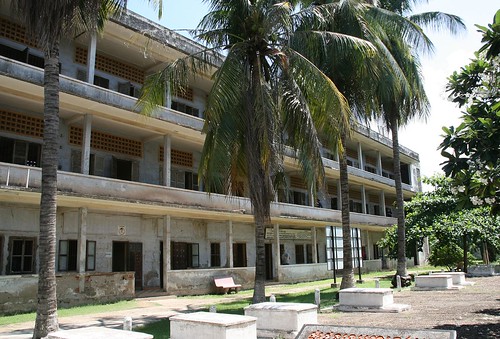
Toul Sleng Genocide Museum
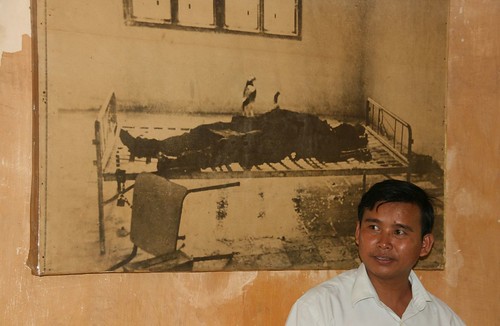
Photograph of Tortured Prisoner
The Khmer Rouge, like the Nazi party, was meticulous about keeping records and they photographed and logged every prisoner that entered S-21. There are rooms filled with the photographs of these prisoners, from young children to the elderly. There are also photographs of a few of the foreigners who were caught in the madness (including a handful of journalists).
Today the grounds are peaceful. The grass is green and lush, there are flowers in the trees and people relax on benches in the shade. If you didn’t know the history, and ignored the lengths of barbed wire enclosing the prison, you might mistake it for just another decrepit Phnom Penh building complex. But paintings depicting torture, a room where large cases contain skulls and graves containing those 14 VIPs tell you it’s something else entirely.
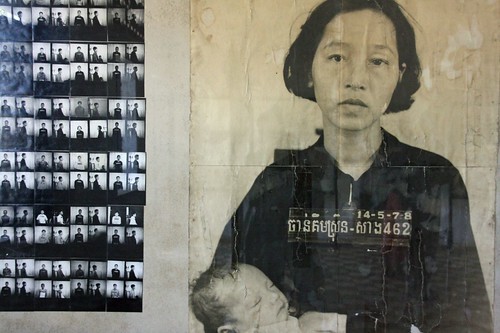
May 14, 1978
The Toul Sleng Genocide Museum is educational, sobering, tragic, depressing and downright creepy, a reminder of the horrific extremes humans are capable of. At the Killing Fields of Choeung Ek, the final dagger is plunged to the hilt.
The site lies 15 kilometers to the south. The 17,000 prisoners who had been detained and tortured at S-21 were transferred to the fields, where they were bludgeoned to death (why waste bullets?). Their remains were dumped into 129 mass graves. The remains of 9,000 victims have been unearthed from 86 of the graves. The remaining corpses are still in the ground. With year after year of rainfall, tourist traffic and natural erosion, bone fragments and bits of old cloth surface through the hard ground.
A memorial Buddhist stupa was erected in 1988 to commemorate the victims here. The tall, square building contains thousands of skulls and a pile of old clothes. Empty socket and fractured skulls are a painful yet simple reminder of the events that occurred on the site.

Skulls in the Stupa at Choeung Ek
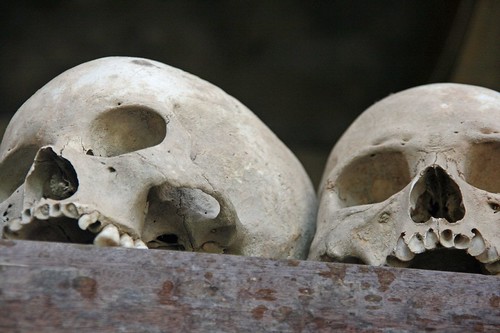
Skulls
The Khmer Rouge is part of Cambodia’s past, even if its leaders have never been brought to trial). For me, visiting the detention center and the killing fields, I felt removed from the horrors of those years. I was able to visit the site and intellectually process what happened. But any attempt to comprehend the reality of the situation is beyond me. Genocide is not something I want to live through, but no one can truly comprehend that level of insanity without experiencing it firsthand. In the end, I visited, listened, learned and remained respectful. Is there anything else a tourist can do?
Sihanouk was suspicious of the United States and in the 1960’s turned to the North Vietnamese and the Chinese for support. Socialist economic policies alienated the right; leftists were upset over internal policies that stifled any form of dissent. Sihanouk felt most threatened by the leftist rebels and instituted repressive policies. One of the rebel groups forced to flee into the jungle for safety was the Khmer Rouge.
Cut to the mid 1970’s. Sihanouk has been deposed by General Lon Nol. U.S. and South Vietnamese forces have invaded the country in an effort to root out the communists. The U.S. institutes a secret policy of bombing communist camps, killing hundreds of thousands. Rural Cambodia falls under the control of the rebels. Pol Pot, a Paris-educated leader of the Khmer Rouge, has formed an army and on April 17, 1975, captures Phnom Penh, taking over the city and setting the clocks back to “Year Zero.” His goal is to turn Cambodia into an agrarian cooperative society under a fusion of idealistic Marxist and Maoist theories.
The reality that ensues is one of the most repressive, bloody and terrifying chapters in modern history.
Pol Pot cleared Phnom Penh of people, relocating residents to the countryside. He then instituted a program to cleanse the country of its/his enemies. The problem was in identifying those enemies. They included leaders of the former regime, warring factions within the Khmer Rouge itself, intellectuals, monks, professionals, etc. No one knows how many people were killed during the three years, eight months and 21 days of Khmer Rouge rule. By the time the Vietnamese invaded, on Christmas Day 1978, hundreds of thousands had been tortured and killed and hundreds of thousands more had died of starvation and disease. Current estimates say more than two million people died as a result of the Khmer Rouge.

This summary is simplistic and incomplete and doesn't do the subject justice. It is merely a preamble to my visit to one of the prisons where the Khmer Rouge held and tortured prisoners and a killing field where those prisoners were executed and then dumped into mass graves.
In the winter of 1975, Toul Svey Prey was a high school 15 kilometers south of the center of Phnom Penh. By the summer of 1975 it had been converted into Security Prison 21 (S-21), the most notorious detention center in the country. More than 17,000 people were held at the site before they were transferred to the Killing Fields at Choeung Ek, a former orchard and Chinese cemetery. An afternoon at both sites is a sobering experience. I realize this is a cliché, but what am I supposed to say when confronting insanity and genocide?
S-21 is now the Toul Sleng Genocide Museum. The grounds remain as they were on the day Vietnamese forces rolled into the city in 1978. The Vietnamese found seven survivors in the camp (that’s seven survivors out of more than 17,000 prisoners who passed through the facility). They also found the corpses of 14 VIPs who had been shackled and tortured. The rooms where these VIPs died each contain an iron bed frame, the shackles and a large black and white photograph showing the condition the corpse was in when discovered. In one photograph, vultures are feeding on the corpse.


The Khmer Rouge, like the Nazi party, was meticulous about keeping records and they photographed and logged every prisoner that entered S-21. There are rooms filled with the photographs of these prisoners, from young children to the elderly. There are also photographs of a few of the foreigners who were caught in the madness (including a handful of journalists).
Today the grounds are peaceful. The grass is green and lush, there are flowers in the trees and people relax on benches in the shade. If you didn’t know the history, and ignored the lengths of barbed wire enclosing the prison, you might mistake it for just another decrepit Phnom Penh building complex. But paintings depicting torture, a room where large cases contain skulls and graves containing those 14 VIPs tell you it’s something else entirely.

The Toul Sleng Genocide Museum is educational, sobering, tragic, depressing and downright creepy, a reminder of the horrific extremes humans are capable of. At the Killing Fields of Choeung Ek, the final dagger is plunged to the hilt.
The site lies 15 kilometers to the south. The 17,000 prisoners who had been detained and tortured at S-21 were transferred to the fields, where they were bludgeoned to death (why waste bullets?). Their remains were dumped into 129 mass graves. The remains of 9,000 victims have been unearthed from 86 of the graves. The remaining corpses are still in the ground. With year after year of rainfall, tourist traffic and natural erosion, bone fragments and bits of old cloth surface through the hard ground.
A memorial Buddhist stupa was erected in 1988 to commemorate the victims here. The tall, square building contains thousands of skulls and a pile of old clothes. Empty socket and fractured skulls are a painful yet simple reminder of the events that occurred on the site.


The Khmer Rouge is part of Cambodia’s past, even if its leaders have never been brought to trial). For me, visiting the detention center and the killing fields, I felt removed from the horrors of those years. I was able to visit the site and intellectually process what happened. But any attempt to comprehend the reality of the situation is beyond me. Genocide is not something I want to live through, but no one can truly comprehend that level of insanity without experiencing it firsthand. In the end, I visited, listened, learned and remained respectful. Is there anything else a tourist can do?

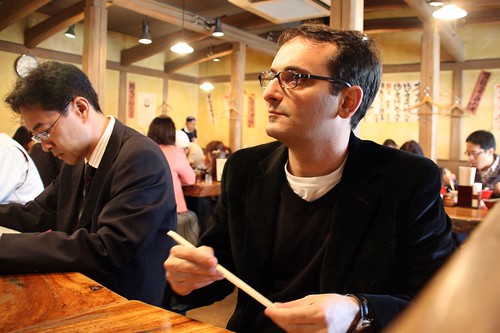

0 Comments:
Post a Comment
<< Home